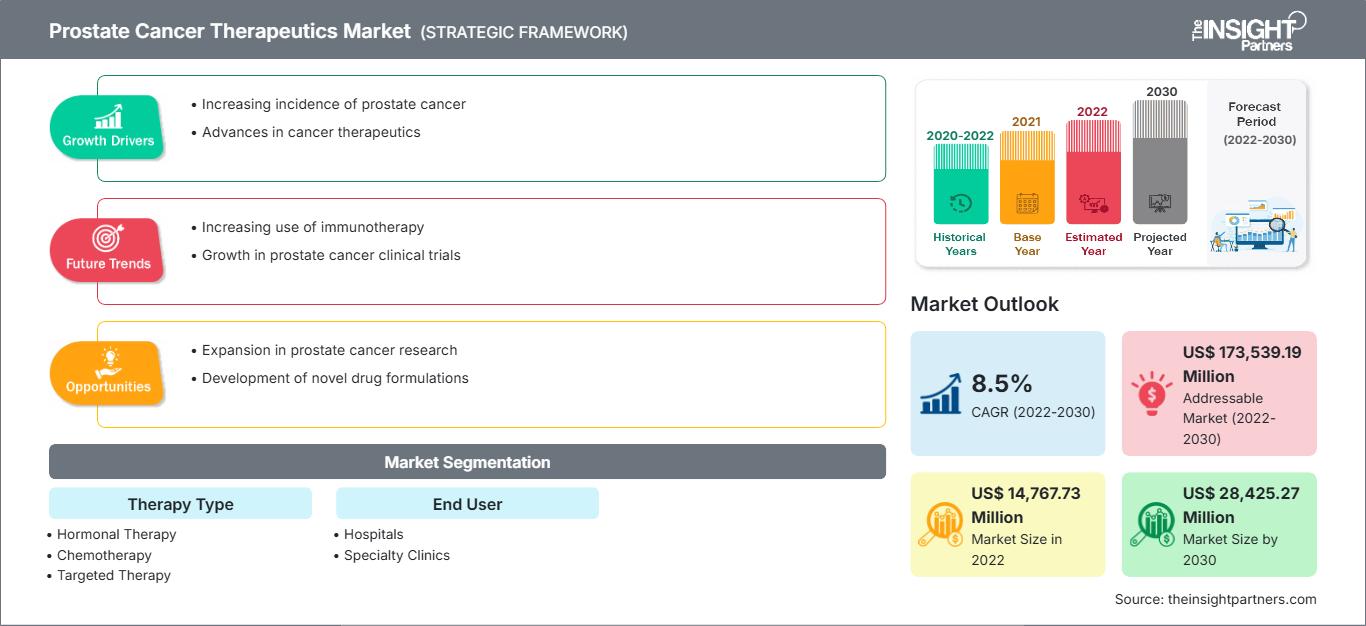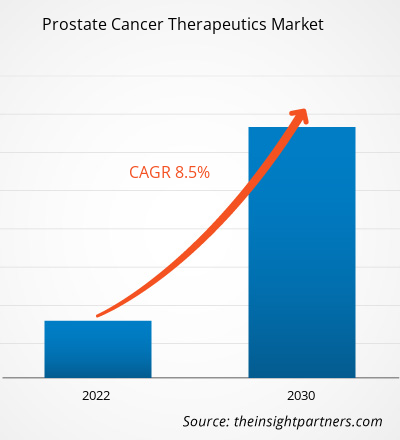[Forschungsbericht] Der Markt für Prostatakrebstherapeutika soll von 14.767,73 Millionen US-Dollar im Jahr 2022 auf 28.425,27 Millionen US-Dollar im Jahr 2030 wachsen; von 2022 bis 2030 wird eine durchschnittliche jährliche Wachstumsrate (CAGR) von 8,5 % erwartet.
Markteinblicke und Analystenmeinungen:
Der Markt für Prostatakrebstherapeutika wächst mit zunehmenden F&E-Aktivitäten zur Einführung neuer Wirkstoffe, der steigenden Zahl von Prostatakrebsfällen und der zunehmenden staatlichen Unterstützung für die Diagnostik von Prostatakrebs. Darüber hinaus treibt die Verfügbarkeit fortschrittlicher Produkte der Marktteilnehmer das Marktwachstum voran. Im Januar 2023 brachte BDR Pharmaceutical eine generische Version von Apalutamid auf den Markt, die in Indien zur Behandlung von Prostatakrebs eingesetzt wird. Das Medikament wird unter dem Markennamen APATIDE auf den Markt gebracht und zur Behandlung von nicht-metastasiertem kastrationsresistentem Prostatakrebs und metastasiertem kastrationssensitivem Prostatakrebs verschrieben.
Wachstumstreiber und Herausforderungen:
Prostatakrebs ist eines der häufigsten Gesundheitsprobleme bei Männern, insbesondere bei älteren Männern ab 50 Jahren. Prostatakrebs tritt am häufigsten bei Männern auf, die fettleibig sind und in deren Familie Prostatakrebs vorkommt. Prostatakrebs ist eine stille Bedrohung, da er sich oft ohne erkennbare Symptome entwickelt. Daher ist die Früherkennung dieser Krebsart nicht so einfach. Die Mehrzahl der Prostatakrebserkrankungen entsteht im peripheren Bereich der Vorsteherdrüse. Damit Symptome auftreten, muss der Krebs eine Größe erreichen, bei der er Druck auf die Harnröhre ausübt, oder Knochenschmerzen durch die Metastasierung können in einigen Fällen das erste Symptom von fortgeschrittenem Prostatakrebs sein. Allerdings sollte jede Person ab 50 Jahren mit Symptomen der unteren Harnwege, erektiler Dysfunktion oder Orhämaturie die Möglichkeit von Prostatakrebs in Betracht ziehen. Prostatakrebs ist weltweit die fünfthäufigste krebsbedingte Todesursache bei Männern und die zweithäufigste Krebsdiagnose. Auch wenn die Zahl der Prostatakrebsfälle seit dem Jahr 2000 zurückgegangen ist, steigt die Zahl der Fälle von Prostatakrebs im Spätstadium seit 2010 wieder an. Die Inzidenz- und Mortalitätsraten bei Prostatakrebs unterscheiden sich stark. In Industrienationen ist die Inzidenz von Prostatakrebs im Allgemeinen höher, die Mortalität jedoch niedriger. Das Prostatakrebsrisiko ist in den USA fast viermal höher als weltweit. Laut der Novartis AG wurden im Jahr 2020 weltweit etwa 1,4 Millionen neue Fälle von Prostatakrebs und etwa 375.000 Todesfälle durch Prostatakrebs gemeldet. Die weltweit steigende Zahl der Prostatakrebsfälle und die niedrige Erkennungsrate von Prostatakrebs treiben das Wachstum des Marktes für Prostatakrebstherapeutika an.
Passen Sie diesen Bericht Ihren Anforderungen an
Sie erhalten kostenlos Anpassungen an jedem Bericht, einschließlich Teilen dieses Berichts oder einer Analyse auf Länderebene, eines Excel-Datenpakets sowie tolle Angebote und Rabatte für Start-ups und Universitäten.
Markt für Prostatakrebstherapeutika: Strategische Einblicke

- Holen Sie sich die wichtigsten Markttrends aus diesem Bericht.Dieses KOSTENLOSE Beispiel umfasst Datenanalysen, die von Markttrends bis hin zu Schätzungen und Prognosen reichen.
Sie erhalten kostenlos Anpassungen an jedem Bericht, einschließlich Teilen dieses Berichts oder einer Analyse auf Länderebene, eines Excel-Datenpakets sowie tolle Angebote und Rabatte für Start-ups und Universitäten.
Markt für Prostatakrebstherapeutika: Strategische Einblicke

- Holen Sie sich die wichtigsten Markttrends aus diesem Bericht.Dieses KOSTENLOSE Beispiel umfasst Datenanalysen, die von Markttrends bis hin zu Schätzungen und Prognosen reichen.
Berichtssegmentierung und -umfang:
Der Markt für Prostatakrebstherapeutika ist nach Therapieart, Endverbraucher und Geografie segmentiert. Der Markt für Prostatakrebstherapeutika ist nach Therapieart in Hormontherapie, Chemotherapie, Immuntherapie, zielgerichtete Therapie und Sonstiges unterteilt. Der Markt für Prostatakrebstherapeutika ist nach Endverbraucher in Krankenhäuser, Fachkliniken und Sonstiges segmentiert. Basierend auf der Geografie ist der Markt für Prostatakrebstherapeutika in Nordamerika (USA, Kanada und Mexiko), Europa (Großbritannien, Deutschland, Frankreich, Italien, Spanien und übriges Europa), Asien-Pazifik (China, Japan, Indien, Südkorea, Australien und übriger Asien-Pazifik-Raum), Naher Osten und Afrika (VAE, Saudi-Arabien, Südafrika und übriger Naher Osten und Afrika) sowie Süd- und Südamerika unterteilt. Mittelamerika (Brasilien, Argentinien und der Rest von Süd- und Mittelamerika).
Segmentanalyse:
Der Markt für Prostatakrebstherapeutika ist nach Therapietyp in Hormontherapie, Chemotherapie, Immuntherapie, zielgerichtete Therapie und andere unterteilt. Im Jahr 2022 hatte das Segment Hormontherapie nach der Chemotherapie den größten Marktanteil, und es wird erwartet, dass dasselbe Segment von 2022 bis 2030 die höchste durchschnittliche jährliche Wachstumsrate (CAGR) verzeichnet. Chemotherapie gilt als wichtige Behandlungsmethode für Prostatakrebs. Bei dieser Therapie zerstören Medikamente die neuen oder vorhandenen Krebszellen in der Lunge. Chemotherapie bei metastasiertem Prostatakrebs kann Symptome lindern. Sie kann auch dazu beitragen, das Krebswachstum zu reduzieren und die Lebensqualität zu verbessern. Docetaxel (Taxotere) gilt als Standardbehandlung bei Chemotherapie von Prostatakrebs bei Patienten, die gegen eine Hormontherapie resistent sind. Die FDA hat außerdem das Chemotherapeutikum Cabazitaxel (Jevtana) zur Behandlung von kastrationsresistentem Prostatakrebs zugelassen. Es wird auch bei Patienten mit metastasiertem Prostatakrebs angewendet, der unter der Einnahme von Docetaxel gewachsen ist.
Regionale Analyse:
Der Markt für Prostatakrebstherapeutika ist geografisch in Nordamerika, Europa, den asiatisch-pazifischen Raum, den Nahen Osten und Afrika sowie Süd- und Mittelamerika unterteilt. Nordamerika trägt am meisten zum globalen Wachstum des Marktes für Prostatakrebstherapeutika bei. Der asiatisch-pazifische Raum wird voraussichtlich zwischen 2022 und 2030 die höchste durchschnittliche jährliche Wachstumsrate (CAGR) im Markt für Prostatakrebstherapeutika verzeichnen. Das Wachstum des Marktes für Prostatakrebstherapeutika in den USA wird hauptsächlich durch die steigende Zahl von Prostatakrebsfällen, Produkteinführungen und Regierungsinitiativen vorangetrieben. Im Juni 2023 wurde Lynparza (Olaparib) von AstraZeneca und MSD in Kombination mit Prednison oder Prednisolon und Abirateron in den USA zur Behandlung erwachsener Patienten mit mutmaßlich schädlichem BRCA-mutiertem (BRCAm) metastasiertem kastrationsresistentem Prostatakrebs (mCRPC) zugelassen. Darüber hinaus genehmigte die FDA im November 2023 Enzalutamid, ein von Astellas Pharma US, Inc. hergestelltes Produkt. Das Produkt wird zur Behandlung von nicht-metastasiertem kastrationssensitivem Prostatakrebs (nmCSPC) mit biochemischem Rezidiv und hohem Metastasierungsrisiko (Hochrisiko-BCR) eingesetzt.
Therapeutika für ProstatakrebsRegionale Einblicke in den Markt für Prostatakrebstherapeutika
Regionale Einblicke in den Markt für Prostatakrebstherapeutika
Die Analysten von The Insight Partners haben die regionalen Trends und Faktoren, die den Markt für Prostatakrebstherapeutika im Prognosezeitraum beeinflussen, ausführlich erläutert. In diesem Abschnitt werden auch die Marktsegmente und die geografische Lage von Prostatakrebstherapeutika in Nordamerika, Europa, dem asiatisch-pazifischen Raum, dem Nahen Osten und Afrika sowie Süd- und Mittelamerika erörtert.
Umfang des Marktberichts zu Prostatakrebstherapeutika
| Berichtsattribut | Einzelheiten |
|---|---|
| Marktgröße in 2022 | US$ 14,767.73 Million |
| Marktgröße nach 2030 | US$ 28,425.27 Million |
| Globale CAGR (2022 - 2030) | 8.5% |
| Historische Daten | 2020-2022 |
| Prognosezeitraum | 2022-2030 |
| Abgedeckte Segmente |
By Therapieart
|
| Abgedeckte Regionen und Länder | Nordamerika
|
| Marktführer und wichtige Unternehmensprofile |
|
Dichte der Marktteilnehmer für Prostatakrebstherapeutika: Auswirkungen auf die Geschäftsdynamik verstehen
Der Markt für Prostatakrebstherapeutika wächst rasant. Die steigende Nachfrage der Endverbraucher ist auf Faktoren wie veränderte Verbraucherpräferenzen, technologische Fortschritte und ein stärkeres Bewusstsein für die Produktvorteile zurückzuführen. Mit der steigenden Nachfrage erweitern Unternehmen ihr Angebot, entwickeln Innovationen, um den Bedürfnissen der Verbraucher gerecht zu werden, und nutzen neue Trends, was das Marktwachstum weiter ankurbelt.

- Holen Sie sich die Markt für Prostatakrebstherapeutika Übersicht der wichtigsten Akteure
Branchenentwicklungen und zukünftige Chancen:
Nachfolgend sind verschiedene Initiativen wichtiger Akteure auf dem Markt für Prostatakrebstherapeutika aufgeführt:
- Im März 2022 genehmigte die US-amerikanische FDA Pluvicto (Lutetium Lu 177 Vipivotid-Tetraxetan) von Novartis zur Behandlung erwachsener Patienten mit einer Art von fortgeschrittenem Prostatakrebs namens Prostataspezifisches Membranantigen-positives metastasiertes kastrationsresistentes Prostatakarzinom (PSMA-positives mCRPC).
- Im April 2023 erteilte die FDA Lantheus Holdings Inc und POINT Biopharma Global Inc den Fast-Track-Status für 177Lu-PNT2002 zur Behandlung von metastasiertem kastrationsresistentem Prostatakarzinom (mCRPC). PNT2002 ist eine innovative, auf PSMA ausgerichtete 177Lu basierende radiopharmazeutische Therapie, die PSMA-gerichteten Liganden, PSMA-I&T und Beta-emittierendes Radioisotop ohne Trägerzusatz 177Lu zur Behandlung von mCRPC kombiniert.
Wettbewerbslandschaft und wichtige Unternehmen:
Astella Pharma Inc, Johnson & Johnson Services Inc, Eli Lilly and Company, Bayer AG, Sanofi, Merck KGaA, AstraZeneca, Novartis AG, AbbVie und Bristol Myers Squibb gehören zu den führenden Akteuren auf dem Markt für Prostatakrebstherapeutika. Diese Marktteilnehmer konzentrieren sich auf die Einführung neuer Produkte und die geografische Expansion, um die weltweit wachsende Verbrauchernachfrage zu erfüllen und ihr Produktangebot in Spezialportfolios zu erweitern. Ihre globale Präsenz ermöglicht es ihnen, einen großen Kundenstamm zu bedienen und so die Marktexpansion zu erleichtern.
- Historische Analyse (2 Jahre), Basisjahr, Prognose (7 Jahre) mit CAGR
- PEST- und SWOT-Analyse
- Marktgröße Wert/Volumen – Global, Regional, Land
- Branchen- und Wettbewerbslandschaft
- Excel-Datensatz
Aktuelle Berichte
Verwandte Berichte
Erfahrungsberichte
Grund zum Kauf
- Fundierte Entscheidungsfindung
- Marktdynamik verstehen
- Wettbewerbsanalyse
- Kundeneinblicke
- Marktprognosen
- Risikominimierung
- Strategische Planung
- Investitionsbegründung
- Identifizierung neuer Märkte
- Verbesserung von Marketingstrategien
- Steigerung der Betriebseffizienz
- Anpassung an regulatorische Trends




















 Kostenlose Probe anfordern für - Markt für Prostatakrebstherapeutika
Kostenlose Probe anfordern für - Markt für Prostatakrebstherapeutika